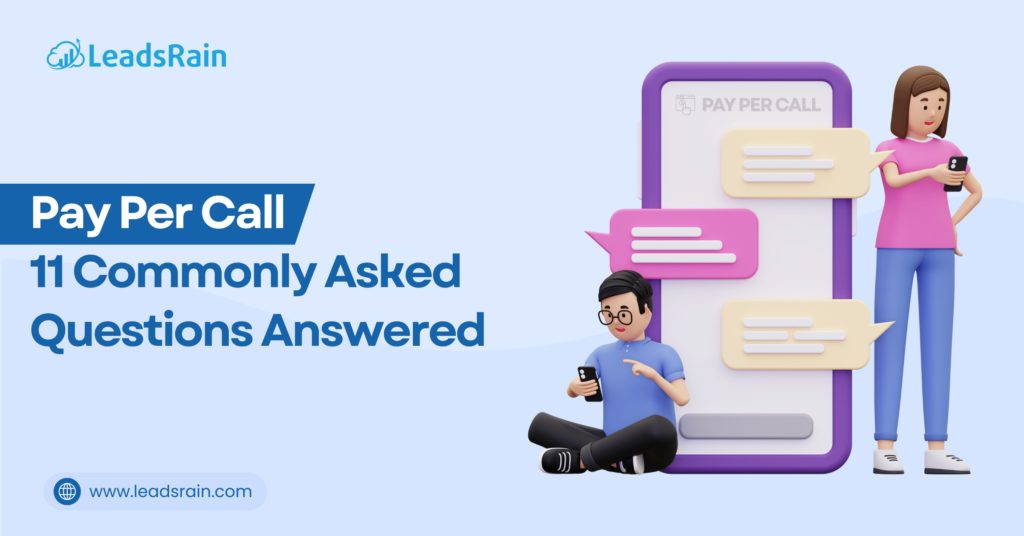Inbound sales teams rely on fast, high-quality interactions to convert interest into revenue. But traditional lead channels like form fills or email opt-ins often fall short—delivering cold or delayed opportunities that frustrate agents and drag down performance.
Pay Per Call changes the game by connecting agents directly with real-time, high-intent callers. These leads are often pre-qualified through ads, IVR, or geo-targeting, making every ring a true sales opportunity. For industries where speed and context matter, it’s a powerful way to boost conversion rates and agent efficiency.
In this article, we’ll break down how Pay Per Call supports inbound sales agents, improves performance metrics, and helps teams scale smarter.
How Pay Per Call Helps Inbound Sales Agents?
Pay Per Call gives inbound sales agents a direct and reliable stream of live prospects without the delays and inefficiencies common in traditional lead generation. Rather than chasing down form submissions or waiting for callbacks, agents receive inbound phone calls from individuals actively engaging with marketing campaigns. The result is more time spent in conversations that lead to conversions, not just data entry and follow-up.
1. Delivers High-Intent, Pre-Qualified Leads
Pay Per Call campaigns are optimized to drive calls from users showing strong purchase or inquiry behavior. The traffic is typically filtered using rules such as device type, location, operating hours, or IVR input, so only qualified users are routed to your sales floor.
Why it matters:
Agents are connected to prospects who are actively seeking assistance and meet your sales criteria.
- Reduces time wasted on unqualified leads
- Higher call-to-close ratios
- Less reliance on outbound follow-ups
- Streamlined sales process
- Fewer call transfers needed
2. Increases Call Volume Without Sacrificing Lead Quality
Pay Per Call scales cleanly—more ad spend results in more live conversations. Because you only pay for calls that meet defined criteria (e.g., 90+ seconds, specific IVR path), quality is maintained even as volume grows.
Why it matters:
Agents stay busy with legitimate sales opportunities throughout the day.
- Keeps sales floor activity high
- Ensures marketing spend produces revenue-ready calls
- Prevents overloading agents with low-quality leads
- Helps managers forecast staffing needs
3. Reduces Time Spent on Lead Nurturing
With Pay Per Call, the nurturing process is handled before the agent even picks up the phone. Whether through a landing page, call center IVR, or targeted ad copy, the lead is already informed and motivated to speak.
Why it matters:
Agents engage in real-time conversations that are closer to conversion.
- Cuts out need for drip emails or SMS campaigns
- Improves daily close rates per agent
- Increases productivity on shorter shifts
- Limits dependency on CRM workflows.
4. Improves Sales Agent Morale and Productivity
Agents perform better when they work with high-quality opportunities. Poor lead quality can wear down morale, increase burnout, and lower overall performance metrics like average call duration and first-call close rate.
Why it matters:
High-quality inbound calls help agents maintain energy, enthusiasm, and performance.
- More wins per shift boosts motivation
- Fewer frustrating conversations
- Lower churn and turnover among reps
- Agents feel their time is being respected
- Better alignment between marketing and sales
5. Provides Actionable Analytics and Transparency
Pay Per Call platforms allow detailed performance tracking, including call recordings, agent outcomes, and campaign-level ROI. You can monitor which sources, times, or agents are producing the best results and optimize in real time.
Why it matters:
Sales leaders and marketers can adjust campaigns and staffing based on real-world performance data.
- Identify top-performing traffic sources
- Track conversion rates by campaign
- Evaluate agent effectiveness per call
- Spot IVR drop-off trends
- Make faster budget allocation decisions
- Monitor compliance and call quality
6. Supports Campaign and Agent Scalability
Pay Per Call is flexible, making it ideal for companies that experience seasonal demand or are expanding to new markets. Campaigns can be scaled up or down quickly without sacrificing control or insights.
Why it matters:
Sales teams can handle fluctuating demand without being overwhelmed or underutilized.
- Adapt lead flow to sales team capacity
- Avoid overstaffing during low-volume periods
- Launch campaigns in new states or niches fast
- Respond to sudden market trends
- Maintain consistent lead quality during growth
How to Set Up a Successful Pay Per Call Program for Inbound Sales?
Building a high-performing Pay Per Call program starts with a solid foundation—from choosing the right partners to ensuring your inbound team is equipped to handle real-time lead volume. Every component, from traffic filters to call routing, must align with your sales process. If executed correctly, this model can deliver a consistent stream of qualified inbound calls that your agents are fully prepared to convert. Below are the key steps to make that happen efficiently and profitably.
1. Partner with Reliable Pay Per Call Networks
Choose networks or affiliate partners with experience in your industry and the ability to offer granular traffic controls. Look for features like publisher transparency, volume caps, IVR customization, and performance tracking. A strong network relationship helps ensure you’re not only buying calls but buying the right kind of calls, reducing agent burnout and improving conversion consistency.
2. Define Clear Call Qualification Filters Before Launch
Before any traffic goes live, create strict call filters that define your ideal prospect profile. Set call duration requirements, restrict geographies you don’t serve, filter by time-of-day, and use IVRs to disqualify mismatches early. The more focused your call criteria, the better aligned your inbound traffic will be with what your agents can actually convert.
3. Train Inbound Sales Agents for High-Intent Conversations
Train agents to quickly identify buyer needs, lead the conversation with confidence, and qualify efficiently. These calls are fast-paced and demand clear communication and quick decision-making.
Scripting should be adaptive, allowing reps to follow the caller’s intent while still steering toward a defined outcome like a sale, appointment, or transfer.
4. Implement a Robust Call Tracking System like LeadsRain
Use a professional call tracking platform such as LeadsRain to monitor call quality, assign unique phone numbers to campaigns, and manage routing rules in real-time. LeadsRain offers features like smart call distribution, keyword-level tracking, and IVR flows that help you direct the right calls to the right agents. Recording and reporting tools also give managers the data they need to refine campaigns and coaching.
5. Use Real-Time Disposition and Feedback Loops
After each call, agents should log detailed call outcomes using preset disposition tags. These insights allow managers to quickly identify what campaigns are delivering results and which aren’t. Real-time feedback helps optimize agent scripts, shift budget to better-performing sources, and maintain quality standards across both the marketing and sales funnels.
6. Scale Gradually with A/B Testing and Controlled Budget Increases
Start small with each traffic source and scale only after validating conversion rates and agent capacity. A/B test ad creatives, IVR flows, and offers to improve call quality without increasing costs. Gradual scaling keeps your operation balanced—ensuring lead volume doesn’t overwhelm agents or dilute performance metrics during growth.
Key Metrics Inbound Teams Should Track with Pay Per Call
Tracking the right performance metrics is critical to optimizing any Pay Per Call strategy. While the goal is to deliver high-converting calls, the real power lies in understanding what happens before, during, and after each interaction. Inbound teams must look beyond surface-level KPIs like volume and instead analyze deeper metrics that reveal traffic quality, agent performance, and conversion health.
These insights help allocate budget effectively, refine call scripts, and improve overall ROI. The stronger your tracking, the faster you can diagnose issues, scale winning campaigns, and deliver predictable sales outcomes.
Here are some of the important key metrics to track:
- Call Duration: Measures the average length of inbound calls to determine caller engagement and qualification efficiency.
- Conversion Rate per Agent: Tracks how many calls each agent successfully converts, helping identify top performers and those needing coaching.
- Qualified Call Rate: Percentage of total calls that meet your qualification criteria (e.g., stayed over 90 seconds, met demographic filters).
- Call Abandonment Rate: Monitors how often calls are dropped before being answered or transferred to a live agent.
- IVR Drop-Off Rate: Shows where callers exit during your IVR process, helping refine or shorten your call flow.
- Call Transfer Success Rate: Tracks how many calls were successfully routed or transferred without hang-ups or misrouted connections.
- Cost Per Qualified Call (CPQC): Calculates the average spend to generate one qualified call that meets your criteria.
- Agent Talk Time vs. Idle Time: Helps balance staffing needs and maximize the use of available sales resources.
- Publisher/Source Performance: Tracks which affiliate, ad network, or keyword source is generating the most valuable calls.
- Time to Answer: Measures how fast agents pick up calls after routing—shorter times improve caller satisfaction and conversion potential.
- Call Recording Review Scores: Internal or automated reviews of agent calls for script adherence, tone, compliance, and effectiveness.
- Daily and Weekly Call Volume Trends: Helps identify peak performance windows, underperforming time slots, and traffic pacing issues.
Final Thoughts
Pay Per Call helps inbound sales teams receive more qualified, ready-to-convert callers without relying on traditional lead forms or cold outreach. When supported with strong tracking systems, clear agent workflows, and targeted traffic sources, it becomes a consistent driver of results for high-performing sales teams.To get the most out of your Pay Per Call campaigns, make sure your setup, tools, and reporting are built for scale and efficiency. If you need help getting started or improving performance, reach out to the team at support@leadsrain.com for expert guidance.




